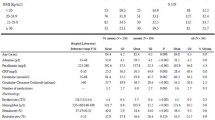Abstract
Anemia is a common finding in elderly individuals. Several studies have shown a strong relationship between anemia, morbidity and mortality, suggesting anemia as a significant independent predictor of adverse outcome in elderly hospitalized patients. The pathophisiology of anemia in the elderly is not yet completely understood. Several mechanisms are involved. We investigated the prevalence of anemia in a cohort of 193 elderly patients admitted to the Internal Medicine Ward of Ca'Granda Policlinico Hospital along 6 months, and its relationship to comorbidities and to the length of hospitalization. Anemia was classified according to the WHO criteria. The majority of patients (48 %) had a mildmoderate, normocytic anemia; severe anemia was found in 8 out of 92 anemic patients. In a subgroup of patients erythropoietin was tested and resulted statistically higher if compared to non-anemic controls (p = 0.003). Considering the most common cause of anemia, nutritional deficiency, chronic renal disease and anemia of chronic disease were found respectively in 36, 15 and 25 % of cases. Unexplained anemia was diagnosed in 24 % of patients, according to the literature. Anemia was independently associated with increased length of hospital stay. Our study confirmed a high prevalence of anemia in elderly patients, and its association with a higher number of comorbidities and a longer stay. A correct clinical approach to anemia in elderly hospitalized patients is essential, considering its negative impact on patients' quality of life, and its social burden in term of healthcare needs and costs.




Similar content being viewed by others
References
Guralnik JM et al (2004) Prevalence of anemia in persons 65 years and older in the United States: evidence for a high rate of unexplained anemia. Blood 104(8):2263–2268
Tettamanti M et al (2010) Prevalence, incidence and types of mild anemia in the elderly: the “health and anemia” population-based study. Haematologica 95(11):1849–1856
Penninx BW et al (2006) Anemia in old age is associated with increased mortality and hospitalization. J Gerontol A Biol Sci Med Sci 61(5):474–479
Woodman R, Ferrucci L, Guralnik J (2005) Anemia in older adults. Curr Opin Hematol 12(2):123–128
Kikuchi M, Inagaki T, Shinagawa N (2001) Five-year survival of older people with anemia: variation with hemoglobin concentration. J Am Geriatr Soc 49(9):1226–1228
Guralnik JM et al (2005) Anemia in the elderly: a public health crisis in hematology. Hematology Am Soc Hematol Educ Program 2005:528–532
Berliner N (2013) Anemia in the elderly. Trans Am Clin Climatol Assoc 124:230–237
Poggiali E, Migone De Amicis M, Motta I (2014) Anemia of chronic disease: a unique defect of iron recycling for many different chronic diseases. Eur J Intern Med 25(1):12–17
Weiss G, Goodnough LT (2005) Anemia of chronic disease. N Engl J Med 352(10):1011–1023
Nathavitharana RL et al (2012) Anaemia is highly prevalent among unselected internal medicine inpatients and is associated with increased mortality, earlier readmission and more prolonged hospital stay: an observational retrospective cohort study. Intern Med J 42(6):683–691
Andro M et al (2013) Anaemia and cognitive performances in the elderly: a systematic review. Eur J Neurol 20(9):1234–1240
Carpenter MA et al (1992) Reduced erythropoietin response to anaemia in elderly patients with normocytic anaemia. Eur J Haematol 49(3):119–121
Kario K, Matsuo T, Nakao K (1991) Serum erythropoietin levels in the elderly. Gerontology 37(6):345–348
Ershler WB et al (2005) Serum erythropoietin and aging: a longitudinal analysis. J Am Geriatr Soc 53(8):1360–1365
Bruunsgaard H, Pedersen BK (2003) Age-related inflammatory cytokines and disease. Immunol Allergy Clin North Am 23(1):15–39
Ferrucci L et al (2005) The origins of age-related proinflammatory state. Blood 105(6):2294–2299
Artz AS et al (2004) Mechanisms of unexplained anemia in the nursing home. J Am Geriatr Soc 52(3):423–427
Pang WW et al (2011) Human bone marrow hematopoietic stem cells are increased in frequency and myeloid-biased with age. Proc Natl Acad Sci USA 108(50):20012–20017
National Kidney Foundation (2002) K/DOQI clinical practice guidelines for chronic kidney disease: evaluation, classification, and stratification. Am J Kidney Dis 39(2 Suppl 1):S1–S266
Ershler WB et al (2005) Economic burden of patients with anemia in selected diseases. Value Health 8(6):629–638
Ferrucci L et al (2007) Unexplained anaemia in older persons is characterised by low erythropoietin and low levels of pro-inflammatory markers. Br J Haematol 136(6):849–855
Robinson B et al (2007) Prevalence of anemia in the nursing home: contribution of chronic kidney disease. J Am Geriatr Soc 55(10):1566–1570
Roy CN (2010) Anemia of inflammation. Hematology Am Soc Hematol Educ Program 2010:276–280
Macdougall IC, Cooper AC (2002) Erythropoietin resistance: the role of inflammation and pro-inflammatory cytokines. Nephrol Dial Transplant 17(Suppl 11):39–43
Horl WH (2007) Clinical aspects of iron use in the anemia of kidney disease. J Am Soc Nephrol 18(2):382–393
Conflict of interest
None.
Author information
Authors and Affiliations
Corresponding author
Rights and permissions
About this article
Cite this article
Migone De Amicis, M., Poggiali, E., Motta, I. et al. Anemia in elderly hospitalized patients: prevalence and clinical impact. Intern Emerg Med 10, 581–586 (2015). https://doi.org/10.1007/s11739-015-1197-5
Received:
Accepted:
Published:
Issue Date:
DOI: https://doi.org/10.1007/s11739-015-1197-5




